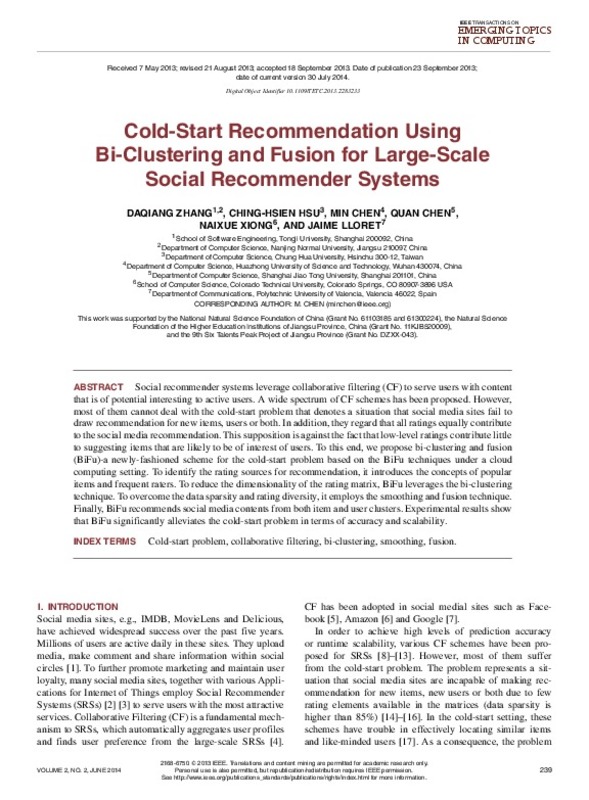JavaScript is disabled for your browser. Some features of this site may not work without it.
Buscar en RiuNet
Listar
Mi cuenta
Estadísticas
Ayuda RiuNet
Admin. UPV
Cold-start Recommendation Using Bi-clustering and Fusion For Social Recommender Systems
Mostrar el registro sencillo del ítem
Ficheros en el ítem
| dc.contributor.author | ZHANG, DAQIANG
|
es_ES |
| dc.contributor.author | HSU, CHING-HSIEN
|
es_ES |
| dc.contributor.author | CHEN, MIN
|
es_ES |
| dc.contributor.author | CHEN, QUAN
|
es_ES |
| dc.contributor.author | XIONG, NAIXUE
|
es_ES |
| dc.contributor.author | Lloret, Jaime
|
es_ES |
| dc.date.accessioned | 2014-12-02T13:19:43Z | |
| dc.date.available | 2014-12-02T13:19:43Z | |
| dc.date.issued | 2014-06 | |
| dc.identifier.issn | 2168-6750 | |
| dc.identifier.uri | http://hdl.handle.net/10251/45109 | |
| dc.description.abstract | Social recommender systems leverage collaborative filtering (CF) to serve users with content that is of potential interesting to active users. A wide spectrum of CF schemes has been proposed. However, most of them cannot deal with the cold-start problem that denotes a situation that social media sites fail to draw recommendation for new items, users or both. In addition, they regard that all ratings equally contribute to the social media recommendation. This supposition is against the fact that low-level ratings contribute little to suggesting items that are likely to be of interest of users. To this end, we propose bi-clustering and fusion (BiFu)-a newly-fashioned scheme for the cold-start problem based on the BiFu techniques under a cloud computing setting. To identify the rating sources for recommendation, it introduces the concepts of popular items and frequent raters. To reduce the dimensionality of the rating matrix, BiFu leverages the bi-clustering technique. To overcome the data sparsity and rating diversity, it employs the smoothing and fusion technique. Finally, BiFu recommends social media contents from both item and user clusters. Experimental results show that BiFu significantly alleviates the cold-start problem in terms of accuracy and scalability. | es_ES |
| dc.description.sponsorship | This work was supported by the National Natural Science Foundation of China (Grant No. 61103185 and 61300224), the Natural Science Foundation of the Higher Education Institutions of Jiangsu Province, China (Grant No. 11KJB520009), and the 9th Six Talents Peak Project of Jiangsu Province (Grant No. DZXX-043). | en_EN |
| dc.language | Inglés | es_ES |
| dc.publisher | Institute of Electrical and Electronics Engineers (IEEE): OAJ | es_ES |
| dc.relation.ispartof | IEEE Transactions on Emerging Topics in Computing | es_ES |
| dc.rights | Reserva de todos los derechos | es_ES |
| dc.subject | Cold-start problem | es_ES |
| dc.subject | Collaborative filtering | es_ES |
| dc.subject | Bi-clustering | es_ES |
| dc.subject | Smoothing | es_ES |
| dc.subject | Fusion | es_ES |
| dc.subject.classification | INGENIERIA TELEMATICA | es_ES |
| dc.title | Cold-start Recommendation Using Bi-clustering and Fusion For Social Recommender Systems | es_ES |
| dc.type | Artículo | es_ES |
| dc.identifier.doi | 10.1109/TETC.2013.2283233 | |
| dc.relation.projectID | info:eu-repo/grantAgreement/NSFC//61300224/ | es_ES |
| dc.relation.projectID | info:eu-repo/grantAgreement/NSFC//61103185/ | es_ES |
| dc.relation.projectID | info:eu-repo/grantAgreement/Natural Science Research of Jiangsu Higher Education Institutions of China//11KJB520009/ | es_ES |
| dc.relation.projectID | info:eu-repo/grantAgreement/Six Talent Peaks Project in Jiangsu Province//DZXX-043/ | es_ES |
| dc.rights.accessRights | Abierto | es_ES |
| dc.contributor.affiliation | Universitat Politècnica de València. Departamento de Comunicaciones - Departament de Comunicacions | es_ES |
| dc.contributor.affiliation | Universitat Politècnica de València. Instituto de Investigación para la Gestión Integral de Zonas Costeras - Institut d'Investigació per a la Gestió Integral de Zones Costaneres | es_ES |
| dc.description.bibliographicCitation | Zhang, D.; Hsu, C.; Chen, M.; Chen, Q.; Xiong, N.; Lloret, J. (2014). Cold-start Recommendation Using Bi-clustering and Fusion For Social Recommender Systems. IEEE Transactions on Emerging Topics in Computing. 2(2):239-250. https://doi.org/10.1109/TETC.2013.2283233 | es_ES |
| dc.description.accrualMethod | S | es_ES |
| dc.relation.publisherversion | http://dx.doi.org/10.1109/TETC.2013.2283233 | es_ES |
| dc.description.upvformatpinicio | 239 | es_ES |
| dc.description.upvformatpfin | 250 | es_ES |
| dc.type.version | info:eu-repo/semantics/publishedVersion | es_ES |
| dc.description.volume | 2 | es_ES |
| dc.description.issue | 2 | es_ES |
| dc.relation.senia | 265794 | |
| dc.contributor.funder | Natural Science Research of Jiangsu Higher Education Institutions of China | es_ES |
| dc.contributor.funder | National Natural Science Foundation of China | es_ES |
| dc.contributor.funder | Six Talent Peaks Project in Jiangsu Province | es_ES |








